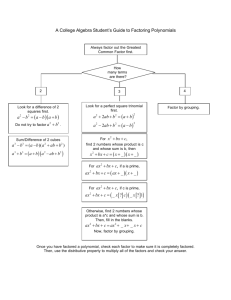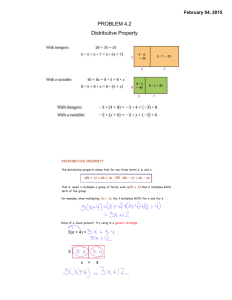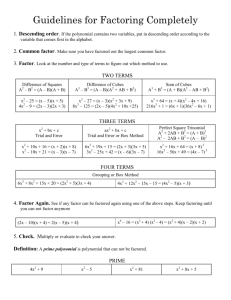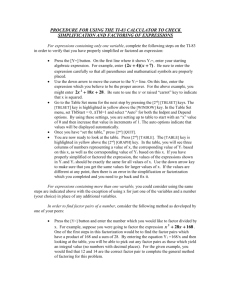Cartesian Factoring of Polyhedra in Linear Relation
advertisement
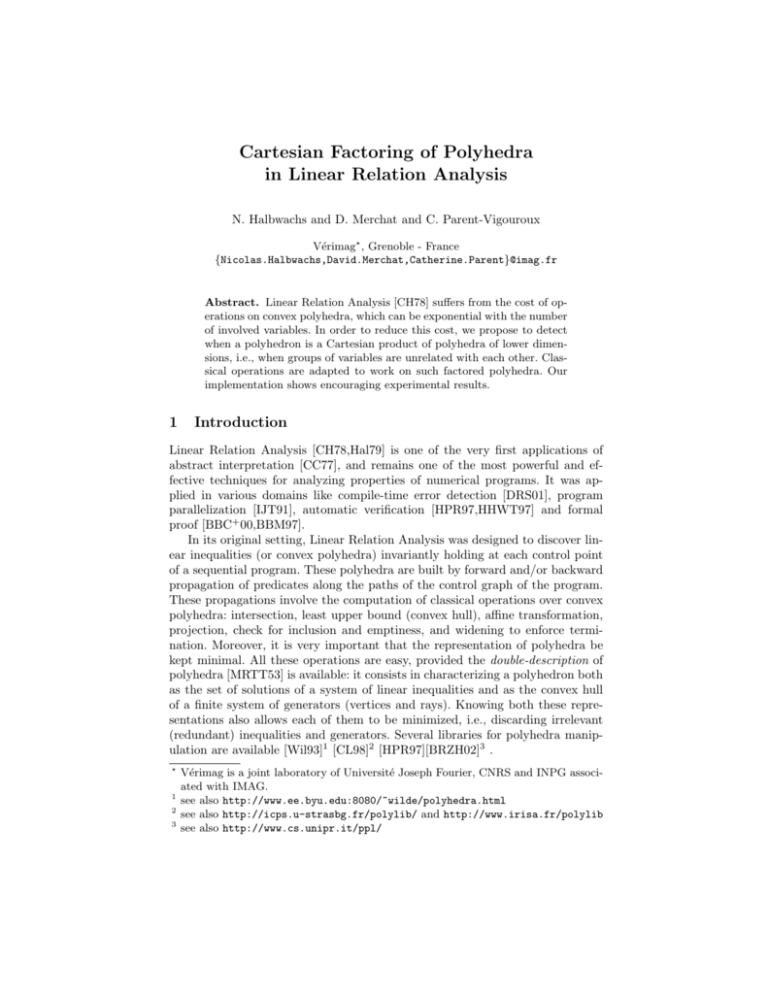
Cartesian Factoring of Polyhedra
in Linear Relation Analysis
N. Halbwachs and D. Merchat and C. Parent-Vigouroux
Vérimag? , Grenoble - France
{Nicolas.Halbwachs,David.Merchat,Catherine.Parent}@imag.fr
Abstract. Linear Relation Analysis [CH78] suffers from the cost of operations on convex polyhedra, which can be exponential with the number
of involved variables. In order to reduce this cost, we propose to detect
when a polyhedron is a Cartesian product of polyhedra of lower dimensions, i.e., when groups of variables are unrelated with each other. Classical operations are adapted to work on such factored polyhedra. Our
implementation shows encouraging experimental results.
1
Introduction
Linear Relation Analysis [CH78,Hal79] is one of the very first applications of
abstract interpretation [CC77], and remains one of the most powerful and effective techniques for analyzing properties of numerical programs. It was applied in various domains like compile-time error detection [DRS01], program
parallelization [IJT91], automatic verification [HPR97,HHWT97] and formal
proof [BBC+ 00,BBM97].
In its original setting, Linear Relation Analysis was designed to discover linear inequalities (or convex polyhedra) invariantly holding at each control point
of a sequential program. These polyhedra are built by forward and/or backward
propagation of predicates along the paths of the control graph of the program.
These propagations involve the computation of classical operations over convex
polyhedra: intersection, least upper bound (convex hull), affine transformation,
projection, check for inclusion and emptiness, and widening to enforce termination. Moreover, it is very important that the representation of polyhedra be
kept minimal. All these operations are easy, provided the double-description of
polyhedra [MRTT53] is available: it consists in characterizing a polyhedron both
as the set of solutions of a system of linear inequalities and as the convex hull
of a finite system of generators (vertices and rays). Knowing both these representations also allows each of them to be minimized, i.e., discarding irrelevant
(redundant) inequalities and generators. Several libraries for polyhedra manipulation are available [Wil93]1 [CL98]2 [HPR97][BRZH02]3 .
?
1
2
3
Vérimag is a joint laboratory of Université Joseph Fourier, CNRS and INPG associated with IMAG.
see also http://www.ee.byu.edu:8080/~wilde/polyhedra.html
see also http://icps.u-strasbg.fr/polylib/ and http://www.irisa.fr/polylib
see also http://www.cs.unipr.it/ppl/
The problem with the double-description is that the size of each description
can grow exponentially with the dimension of the space (number of variables):
an n-dimensional hypercube is defined by 2n inequalities, but has 2n vertices;
the converse can happen, since the descriptions are completely dual.
As a consequence, the dimension of the space is an important limitation to
the application of Linear Relation Analysis to real-life examples. In program
verification, a classical way of decreasing the number of variables, consists of
applying first a program slicing [Tip95]: it consists in analyzing variables dependencies to discard variables which cannot influence the property to be verified.
However, precise slicing is not always easy, and the approach works only when
the goal of the analysis is precisely known (e.g., a given property to verify) to
be used as the source of the slicing.
In this paper, we propose a complementary approach to reduce the number
of variables. It consists in detecting that a polyhedron can be factored as a
Cartesian product of polyhedra in smaller dimensions. This situation, which
occurs very often in real-life examples, means that the set of variables can be
partitioned into subsets, such that variables belonging to different subsets are
independent, i.e., not related by any inequality in the polyhedron. In order to
take advantage of such factorings, they must be detected, and operations should
be, as far as possible, performed on factored arguments.
Compared with slicing, our approach will detect variables independence, not
in an absolute way, but with respect to the analysis which is performed: some
variables may be related by the concrete semantics of the program, but these relations may be ignored by the Linear Relation Analysis, because of approximation.
However, notice that in this paper, we consider factoring without additional loss
of information. Of course, one could also decide to abstract away some relations
in order to obtain a finer factoring and better performances.
2
Convex Polyhedra
2.1
The double description
Let N be either R or Q. A closed convex polyhedron — or simply, a polyhedron
— P in N n can be characterized by a m × n matrix A and a m-vector B, such
that
P = {X ∈ N n | AX ≤ B}
(A, B) is the constraint description of P . A polyhedron P can be also characterized by two finite sets V = {vi }, R = {rj } of n-vectors, such that
|V |
|R|
|V |
X
X
X
P =
λi vi +
µj rj λi ≥ 0, µj ≥ 0,
λi = 1
|
i=1
j=1
i=1
(V, R) is the system of generators of P 4 ; V is the set of vertices, R is the set
of rays. This description expresses that any point in P is the sum of a convex
4
The system of generators of the empty polyhedron is (∅, ∅).
combination of vertices and a positive combination of rays. Fig. 1 illustrates this
double description.
y
−1 −1 −3
x
−1 1
≤ 1
y
−1
−1
3
2
V0 =
1
1
2
3
1
2
1
1
, V1 =
, R0 =
, R1 =
2
1
0
1
x
Fig. 1. Double description of a polyhedron.
Chernikova’s algorithm [Che68] improved by Leverge [LeV92,Wil93] performs
the translation from one description to the other. An important feature of this
algorithm is that the resulting description is minimal, in the sense that it does
not contain any redundant element: A constraint, a vertex, or a ray is redundant
if removing it does not change the polyhedron. In the example of Fig. 1, x ≥ 0
would be a redundant constraint, (2, 2) would be a redundant vertex, and (2, 1)
would be a redundant ray.
Notations: In the rest of the paper, we will generally assimilate a polyhedron
with its system of constraints, for instance by noting P ∧ P 0 the set of solutions
of the conjunction of the constraints of P and P 0 . Notice that we will use this
notation even if the constraints of P and P 0 do not involve the same set of
variables, meaning that the conjunction concerns the union of the variables of
P and P 0 .
2.2
Operations on polyhedra
As soon as both descriptions are available, all operations needed for program
analysis are available:
0
0
Intersection: Let (A,
) be the respective systems of constraints of
B),(A
, B A
B
P1 and P2 , then
,
(the concatenation, or conjunction, of the
A0
B0
systems of constraints) is a system of constraints of P ∩ P 0 . Of course, this
conjunction can result in redundant constraints.
Convex hull: The convex hull is used as an approximation of union, which is
not an internal operation on polyhedra (it does not preserve convexity). The
convex hull of two polyhedra is the least convex polyhedron which contains
both of them. Let (V, R), (V 0 , R0 ) be the respective systems of generators of
P1 and P2 , then (V ∪ V 0 , R ∪ R0 ) is a system of generators of their convex
hull, noted P t P 0 . Again, this system of generators is generally not minimal.
Affine transformation: An affine transformation in N n is given by a pair
(C, D), where C is a n × n matrix and D is a n-vector. The image of a
polyhedron P by an affine transformation (C, D) is
CP + D = {CX + D | X ∈ P }
Then, if (V, R) is a system of generators of P , (CV + D, CR) is a system of
generators of CP + D. When C is invertible, the transformation can also be
done on P ’s system of constraints, and the affine transformation preserves
the minimality of both descriptions.
Existential quantification: We note ∃xj , P the results of eliminating the j-th
variable in P by the Fourier-Motzkin procedure: it consists of replacing each
constraint Ai X ≤ B where Aij > 0 by its positive combinations with all
constraints Ak X ≤ B where Akj < 0 to get a null coefficient for Xj (i.e.,
(Aij .Ak − Akj .Ai )X ≤ (Aij .Bk − Akj .Bi )). Existential quantification of xj
can be easily done, also, on systems of generators, simply by adding uj and
−uj as new rays, where uj is the jth unit vector of N n .
Test for inclusion: Let (V, R) be a system of generators of P , and (A, B) be
a system of constraints of P 0 . Then P ⊆ P 0 if and only if Av ≤ B, for all
v ∈ V , and Ar ≤ 0, for all r ∈ R.
Test for emptiness: A polyhedron is empty if and only if its set of vertices is
empty.
Widening: The widening is used to extrapolate the limit of an increasing sequence of polyhedra. There is some freedom in defining such an operator, we
use the one proposed in [Hal79]. Intuitively, the system of constraints of the
widening P ∇P 0 is the subset of P ’s constraints still satisfied by P 0 . Now,
since this definition relies on the system of constraints of P , which is not
canonical in general, the actual definition is more complex: a constraint of
P ∇P 0 is a constraint of P 0 which is mutually redundant5 with a constraint of
P (meaning that either it is a constraint of P , or it can replace a constraint
of P without changing it). Here again, both descriptions are used to perform
this operation.
3
Factoring of Polyhedra
Let I be a subset of {1 . . . n}. We note P ↓ I the projection of the polyhedron P on
variables with indices in I (i.e., the result, in N |I| of the existential quantification
of all variables with indices outside I).
Let (I1 , I2 , . . . I` ) be a partition of {1 . . . n}. We say that a polyhedron P can
be factored according to (I1 , I2 , . . . I` ) if and only if
5
Two constraints are mutually redundant in a system of constraints if you can replace
each of them by the other without changing the set of solutions.
P = P ↓ I1 × P ↓ I2 × . . . P ↓ I`
A matrix A is block-diagonalizable according to a partition (I1 , I2 , . . . I` ) if for
each of its row Ai there is one ki ∈ {1..`} such that {j | Aji 6= 0} ⊆ Iki .
Some obvious facts:
f1. for any polyhedron P , there is a greatest partition (I1 , I2 , . . . I` ) according
to which P can be factored (possibly the trivial partition, with ` = 1).
f2. for any matrix A, there is a greatest partition (I1 , I2 , . . . I` ) according to
which A is block-diagonalizable (possibly the trivial partition, with ` = 1).
f3. if (A, B) is the constraint description of a polyhedron P , and if A is blockdiagonalizable according to a partition (I1 , I2 , . . . I` ), then P can be factored
according to (I1 , I2 , . . . I` ) (the converse is not true, if (A, B) is not minimal).
This gives an easy way to factor a polyhedron, and to get the constraint
descriptions of its factors: each constraint (Ai , Bi ) becomes a constraint of
the factor Pki .
f4. For any pair (P, P 0 ) of polyhedra (resp., for any pair (A, A0 ) of matrices)
there is a greatest common partition (possibly the trivial partition) according
to which both polyhedra can be factored (resp., both matrices are blockdiagonalizable).
f5. Conversely, given a description of the factors P1 , . . . P` , one can easily obtain
the corresponding description of P = P1 × . . . × P` :
– its system of constraints is just the conjunction of those of the factors;
– its system of generators is obtained by composing together all the `tuples of vertices (resp., of rays) of the factors. This composition explains Q
the explosion of the
Q`size of the systems of generators, since
`
|V | = k=1 |Vk | and |R| = k=1 |Rk |.
A similar treatment works also to obtain a description of P factored according to any partition rougher than (I1 , I2 , . . . I` ).
Example: Fig. 2 shows a factored polyhedron in 2 dimensions. In its minimal
system of constraints:
−1 0 −1
x
0 1
≤ 2
y
0 −1
0
the matrix is block-diagonal. Now, if the redundant constraint 2x ≥ y is added,
the matrix is non longer block-diagonalizable, and the factoring of the polyhedron is hidden.
4
Easy Operations
Most of the operations mentioned in Section 2.2 can be easily applied componentwise to factored polyhedra. The operands need first to be factored in the
2x ≥ y
y
2
x≥1
0≤y≤2
1
x
Fig. 2. A factored polyhedron.
same way (using f4 and f5 above). Moreover, in many cases, the result may be
better factored than the operands, which can be done using f2.
Intersection. If P and P 0 are factored according to the same partition
(I1 , I2 , . . . I` ), then so is P ∩ P 0 = P1 ∩ P10 × P2 ∩ P20 × . . . × P` ∩ P`0 .
It may be the case that P ∩ P 0 can be further factored (Fig. 3).
(a) same factorization
(b) better factorization
Fig. 3. Intersection of factored polyhedra.
Affine transformation. Let X 7→ CX + D be an affine transformation. If C is
block-diagonalizable according to (I1 , I2 , . . . I` ), and P is factored according
to the same partition, then so is CP +D = CI1 P1 +DI1 × . . . × CI` P` +DI` .
If C is not invertible, it can be the case that CP + D can be further factored.
Widening. If P and P 0 are factored according to the same partition
(I1 , I2 , . . . I` ), then so is P ∇P 0 = P1 ∇P10 × P2 ∇P20 × . . . × P` ∇P`0 . It
may be the case (in fact, it happens very often) that P ∇P 0 can be further
factored
Emptiness and inclusion. Let P = P1 × P2 × . . . × P` . Then P is empty
if and only if there exists k ∈ {1..`} such that Pk is empty. If P and P 0 are
factored according to the same partition (I1 , I2 , . . . I` ), then P ⊆ P 0 if and
only if, for all k ∈ {1..`}, Pk ⊆ Pk0 .
5
The Convex Hull
The computation of the convex hull is more difficult. The convex hull of two
factored polyhedra can be either less factored (Fig. 4.a) or as factored (Fig. 4.b),
or even more factored (Fig. 4.c) than the operands.
(a) less factorization
(b) same factorization
(c) better factorization
Fig. 4. Convex hull of factored polyhedra.
The goal is to get the factored result, when possible, in a decomposed way,
and without penalizing the computation when the result is not factored. This
can be achieved thanks to the following proposition:
Proposition 1. Let P = P1 × P2 and P 0 = P10 × P20 be two polyhedra factored
according to the same partition. Let λ be a fresh variable and let us consider the
polyhedra Q1 and Q2 defined by:
Q1 = (P1 ∧ {λ = 0}) t (P10 ∧ {λ = 1}) Q2 = (P2 ∧ {λ = 0}) t (P20 ∧ {λ = 1})
Then,
– if λ is lower-bounded by a non constant expression in Q1 — i.e., there is
a constraint E(X1 ) ≤ λ in the system of constraints of Q1 , where E(X1 )
is a non constant linear expression of X1 — and upper-bounded by a non
constant expression in Q2 , or conversely, the convex hull P t P 0 is non longer
factored, and can be computed as ∃λ, Q1 ∧ Q2 ;
– otherwise P t P 0 = (∃λ, Q1 ) × (∃λ, Q2 ).
Proof: By definition of the convex hull,
X ∈ P t P 0 ⇔ ∃Y ∈ P, Y 0 ∈ P 0 , λ ∈ [0, 1], such that X = λY + (1 − λ)Y 0
⇔ X = (X1 , X2 ) ∧ ∃λ ∈ [0, 1] such that
∃Y1 ∈ P1 , Y10 ∈ P10 , X1 = λY1 + (1 − λ)Y10 ∧
∃Y2 ∈ P2 , Y20 ∈ P20 , X2 = λY2 + (1 − λ)Y20
⇔ X = (X1 , X2 ) ∧ ∃λ ∈ [0, 1] such that
(X1 , λ) ∈ Q1 ∧ (X2 , λ) ∈ Q2
Now, the existential quantification of λ in the last system of constraints can only
produce dependencies between previously independent variables in two cases:
– if there is some constraint E(X1 ) ≤ λ in Q1 , and some constraint λ ≤ F (X2)
in Q2 — which will produce E(X1 ) ≤ F (X2 );
– or, conversely, if there is some constraint λ ≤ E(X1 ) in Q1 , and some constraint F (X2) ≤ λ in Q2 — which will produce F (X2 ) ≤ E(X1 );
where E(X1 ) and F (X2) are non constant expressions. Otherwise, λ can be
quantified separately in Q1 and Q2 .
2
This result generalizes to multiple factorings:
Proposition. Let P = P1 × . . . × P` and P 0 = P10 × . . . × P`0 be two polyhedra
factored according to the same partition. Let λ be a fresh variable and let us
consider the polyhedra (Qk )k=1..` defined by:
Qk = (Pk ∧ {λ = 0}) t (Pk0 ∧ {λ = 1}
Then, the partition of P t P 0 is obtained from (I1 , . . . , I` ) by merging Ik and
Ik0 whenever either λ is lower-bounded by a non constant expression in Qk
and upper-bounded by a non constant expression in Qk0 , or conversely. Let
(J1 , . . . , Jh ) be the resulting partition, each Jm being a union of some Ik s. Then
P t Q = R1 × R2 × . . . × Rh where Rm = ∃λ,
6
×
Ik ⊆ Jm
Qk
Experimental Results
6.1
Operations on factored hypercubes
We first compared the performances of the operations in the best case, where
operands are completely factored hypercubes (i.e., in fact, intervals). For
intersection and widening6 , the results are, of course, excellent:
Intersection Classical operations
Factored operations
Dimension
10 11 12
13
10 20 30 40 50
Operation time 3” 13” 60”
4’36 0”02 0”03 0”03 0”04 0”07
Widening
Classical operations
Factored operations
Dimension
8 10 12
14
16
10 20 30 40 50
Operation time 0”05 0”22 1”68 20”63 6’58” 0”01 0”02 0”04 0”06 0”07
Concerning the convex-hull, we made two series of experiments:
– the first one concerns the best case, where the result is still fully factored.
The following table only gives the times of the classical convex hull, since the
factored one gives non measurable times (less than 0.01 sec. in dimension
50): in dimension n, it performs n convex hulls of polyhedra with 2 variables
(the current variable and the variable λ of Prop. 1).
Dimension 10 11 12
13
14
15
16
Classical 0”06 0”28 2”01 12”07 54”99 3’44” 15’27”
– the second series concerns the worst case, where the result is not factored at
all:
6
Operands are such that half of the constraints are kept by the widening.
Dimensions 10 11 12
13
14
15
16
Classical 0”09 0”48 3”81 21”89 1’35” 6’29” 25’54”
Factored 0”17 0”41 2”93 5”76 1’20” 5’50” 22’53
Notice that, even in this case, the factored operation is still better than
the classical one. In addition with the same operations than in the previous
case, it has to perform an existential quantification of λ, which appears to
dominate largely in the overall cost.
6.2
Experiments in program analysis
Real experiments in program analysis are more difficult to conduct, for the following reason: our verification tool, NBac [JHR99] performs much more than
a simple analysis, since it deals with successive forward and backward analyses together with slicing and dynamic partitioning. As a consequence, the cost
of polyhedra operations is not always prominent. Our experiments concerned
parameterized problems, where the number of numeric variables can be easily
increased without increasing the rest of the treatment. Let us show a few results:
Problem
car
Dimension
4
5
6
7
Time without factoring 1”63 4”74 7”79 55’31”
Time with factoring
3”84 10”48 16”09 2’55”
Problem
Ntoggle
Dimension
4
5
6
7
Time without factoring 1”39 2”01 3”40 44’51”
Time with factoring
3”21 4”60 7”71 16”32
Of course, these results should be taken with care, and further experiments
must be conducted. However, all our experiments show that the factored version
outperforms the classical one from a quite small dimension (less than 10, in
general). We will start experiments in a completely different context, by linking
the analyzer of [DRS03] with our library with factored operations.
7
Conclusion and Future Works
We presented an adaptation of classical operations on polyhedra to work on
Cartesian products of polyhedra. This adaptation is straightforward, except in
the case of the convex hull. The gain in performance is obvious — and spectacular
— when the arguments of the operations are factored in the same way. So the
interest of the approach relies on the fact that, during an analysis, polyhedra are
indeed factored in similar ways. It appears to be often the case, at least in the
end of an analysis, after the application of the widening, which tends to suppress
dependences between variables.
This work can be pursued in several directions. First, the fact that polyhedra are factored depends on the choice of variables. A simple variable change
(e.g., a rotation) can make possible a factoring. The question is whether the
detection of this fact can be done efficiently enough to make it worthwhile. An
other improvement concerns the beginning of the analysis: as mentioned before,
factoring is more likely to occur at the end, after one or several widenings. Now,
at the beginning of an analysis, variables are tightly dependent; in fact, they
are likely to satisfy linear equations. This suggests to look for an other way of
saving variables, by early detection of these equations [Kar76] and elimination of
variables. Of course, since each equation allows only one variable to be removed,
this technique is less likely to produce spectacular improvements than polyhedra
factoring.
References
[BBC+ 00] N. Bjorner, A. Browne, M. Colon, B. Finkbeiner, Z. Manna, H. Sipma,
and T. Uribe. Verifying temporal properties of reactive systems: A STeP
tutorial. Formal Methods in System Design, 16:227–270, 2000.
[BBM97] N. Bjorner, I. Anca Browne, and Z. Manna. Automatic generation of invariants and intermediate assertions. Theoretical Computer Science, 173(1):49–
87, February 1997.
[BRZH02] R. Bagnara, E. Ricci, E. Zaffanella, and P. M. Hill. Possibly not closed
convex polyhedra and the parma polyhedra library. In M. V. Hermenegildo
and G. Puebla, editors, 9th International Symposium on Static Analysis,
SAS’02, Madrid, Spain, September 2002. LNCS 2477.
[CC77]
P. Cousot and R. Cousot. Abstract interpretation: a unified lattice model
for static analysis of programs by construction or approximation of fixpoints. In 4th ACM Symposium on Principles of Programming Languages,
POPL’77, Los Angeles, January 1977.
[CH78]
P. Cousot and N. Halbwachs. Automatic discovery of linear restraints
among variables of a program. In 5th ACM Symposium on Principles of
Programming Languages, POPL’78, Tucson (Arizona), January 1978.
[Che68]
N. V. Chernikova. Algorithm for discovering the set of all solutions of a
linear programming problem. U.S.S.R. Computational Mathematics and
Mathematical Physics, 8(6):282–293, 1968.
[CL98]
Ph. Clauss and V. Loechner. Parametric analysis of polyhedral iteration
spaces. Journal of VLSI Signal Processing, 19(2), July 1998.
[DRS01] N. Dor, M. Rodeh, and M. Sagiv. Cleanness checking of string manipulations in C programs via integer analysis. In P. Cousot, editor, SAS’01,
Paris, July 2001. LNCS 2126.
[DRS03] N. Dor, M. Rodeh, and M. Sagiv. CCSV: towards a realistic tool for statically detecting all buffer overflows in C. to appear in PLDI03, 2003.
[Hal79]
N. Halbwachs. Détermination automatique de relations linéaires vérifiées
par les variables d’un programme. Thèse de troisième cycle, University of
Grenoble, March 1979.
[HHWT97] T. A. Henzinger, P.-H. Ho, and H. Wong-Toi. Hytech: A model checker for
hybrid systems. Software Tools for Technology Transfer, 1:110–122, 1997.
[HPR97]
N. Halbwachs, Y.E. Proy, and P. Roumanoff. Verification of real-time systems using linear relation analysis. Formal Methods in System Design,
11(2):157–185, August 1997.
[IJT91]
F. Irigoin, P. Jouvelot, and R. Triolet. Semantical interprocedural parallelization: An overview of the PIPS project. In ACM Int. Conf. on Supercomputing, ICS’91, Köln, 1991.
[JHR99]
B. Jeannet, N. Halbwachs, and P. Raymond. Dynamic partitioning in analyses of numerical properties. In A. Cortesi and G. Filé, editors, Static
Analysis Symposium, SAS’99, Venice (Italy), September 1999. LNCS 1694,
Springer Verlag.
[Kar76]
M. Karr. Affine relationships among variables of a program. Acta Informatica, 6:133–151, 1976.
[LeV92]
H. LeVerge. A note on Chernikova’s algorithm. RR. 635, IRISA, February
1992.
[MRTT53] T. S. Motzkin, H. Raiffa, G. L. Thompson, and R. M. Thrall. The double
description method. In H. W. Kuhn and A. W. Tucker, editors, Contribution to the Theory of Games – Volume II. Annals of Mathematic Studies,
nr 28, Princeton University Press, 1953.
[Tip95]
F. Tip. A survey of program slicing techniques. Journal of Programming
Languages, 3(3):121–189, September 1995.
[Wil93]
D. K. Wilde. A library for doing polyhedral operations. RR. 785, IRISA,
December 1993.
